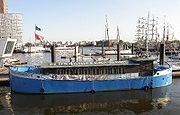
Hamburg Harbour
Encyclopedia

Port
A port is a location on a coast or shore containing one or more harbors where ships can dock and transfer people or cargo to or from land....
in Hamburg
Hamburg
-History:The first historic name for the city was, according to Claudius Ptolemy's reports, Treva.But the city takes its modern name, Hamburg, from the first permanent building on the site, a castle whose construction was ordered by the Emperor Charlemagne in AD 808...
, Germany
Germany
Germany , officially the Federal Republic of Germany , is a federal parliamentary republic in Europe. The country consists of 16 states while the capital and largest city is Berlin. Germany covers an area of 357,021 km2 and has a largely temperate seasonal climate...
, on the river Elbe
Elbe
The Elbe is one of the major rivers of Central Europe. It rises in the Krkonoše Mountains of the northwestern Czech Republic before traversing much of Bohemia , then Germany and flowing into the North Sea at Cuxhaven, 110 km northwest of Hamburg...
. The harbour is located 110 kilometres from the mouth of the Elbe into the North Sea
North Sea
In the southwest, beyond the Straits of Dover, the North Sea becomes the English Channel connecting to the Atlantic Ocean. In the east, it connects to the Baltic Sea via the Skagerrak and Kattegat, narrow straits that separate Denmark from Norway and Sweden respectively...
.
It is named Germany's "Gateway to the World" and is the largest port in Germany. It is the second-busiest port in Europe (after the port of Rotterdam
Port of Rotterdam
The Port of Rotterdam is the largest port in Europe, located in the city of Rotterdam, Netherlands. From 1962 until 2004 it was the world's busiest port, now overtaken by first Shanghai and then Singapore...
), in terms of TEU throughput, and 11th-largest worldwide. 9.74 million containers
Containerization
Containerization is a system of freight transport based on a range of steel intermodal containers...
were handled in Hamburg in 2008.
The harbour covers an area of 73.99 km² (64.80 km² usable), of which 43.31 km² (34.12 km²) are land areas. The location is naturally advantaged by a branching Elbe, creating an ideal place for a port complex with warehousing and transshipment facilities. The extensive free port
Free port
A free port or free zone , sometimes also called a bonded area is a port, port area or other area with relaxed jurisdiction with respect to the country of location...
also enables toll-free shipping.
History
The history of the port is almost as old as the history of HamburgHistory of Hamburg
The history the Hamburg begins with its foundation in the 9th century as a mission settlement to convert the Saxons. Since the Middle Ages Hamburg was an important trading centre in Europe...
herself. Founded on May 7, 1189 by Frederick I
Frederick I, Holy Roman Emperor
Frederick I Barbarossa was a German Holy Roman Emperor. He was elected King of Germany at Frankfurt on 4 March 1152 and crowned in Aachen on 9 March, crowned King of Italy in Pavia in 1155, and finally crowned Roman Emperor by Pope Adrian IV, on 18 June 1155, and two years later in 1157 the term...
for its strategic location, it has been Central Europe
Central Europe
Central Europe or alternatively Middle Europe is a region of the European continent lying between the variously defined areas of Eastern and Western Europe...
's main port for centuries and enabled Hamburg to develop early into a leading city of trade and a rich and proud bourgeoisie.
During the age of the Hanseatic League
Hanseatic League
The Hanseatic League was an economic alliance of trading cities and their merchant guilds that dominated trade along the coast of Northern Europe...
in the 13th to 17th century, Hamburg was considered second only to port and city of Lübeck
Lübeck
The Hanseatic City of Lübeck is the second-largest city in Schleswig-Holstein, in northern Germany, and one of the major ports of Germany. It was for several centuries the "capital" of the Hanseatic League and, because of its Brick Gothic architectural heritage, is listed by UNESCO as a World...
, in terms of its position as a central trading node for sea-borne trade.
During the second half of the 19th century, Hamburg became Central Europe's main hub for transatlantic passenger and freight travel, and from 1871 onward, it was Germany's principal port of trade. The Hamburg America Line
Hamburg America Line
The Hamburg Amerikanische Packetfahrt Actien Gesellschaft was a transatlantic shipping enterprise established in Hamburg, Germany during...
was at her time the largest shipping company in the world. The Free Port, established in on October 15, 1888 enabled traders to ship and store goods without going through customs and further enhanced Hamburg's position in sea trade with neighboring countries. The Moldauhafen
Moldauhafen
Moldauhafen is a lot in the port of Hamburg, Germany, which has been leased since 1929 pursuant to the Treaty of Versailles to Czechoslovakia. In 1993, the Czech Republic succeeded to the rights of Czechoslovakia, and the lease is set to run until 2028.The lot of about is not an exclave, since it...
has a similar arrangement only that it is related to the Czech Republic exclusively.
The Speicherstadt
Speicherstadt
The Speicherstadt in Hamburg, Germany is the largest timber-pile founded warehouse district in the world. It is located in the port of Hamburg—within the HafenCity quarter—and was built from 1883 to 1927.The district was built as a free zone to transfer goods without paying customs...
, one of Hamburg's architectural icons today, is a large wharf area of 350.000 m² floor area on the northern shore of the river built in the 1880s as part of the free port and to cope with the growing amounts of stored goods in the port.
Hamburg shipyards lost fleets twice after WWI and WWII and after the division of Germany between 1945 to 1990, the Port of Hamburg lost most of its hinterland
Hinterland
The hinterland is the land or district behind a coast or the shoreline of a river. Specifically, by the doctrine of the hinterland, the word is applied to the inland region lying behind a port, claimed by the state that owns the coast. The area from which products are delivered to a port for...
and consequently many of its trading connections. However, since German reunification
German reunification
German reunification was the process in 1990 in which the German Democratic Republic joined the Federal Republic of Germany , and when Berlin reunited into a single city, as provided by its then Grundgesetz constitution Article 23. The start of this process is commonly referred by Germans as die...
, the fall of the Iron curtain and European enlargement, Hamburg is substantially making ground as one of Europe's prime logistic centers and as one of the world's busiest and largest sea ports.
The celebration of the harbour's birthday (Hafengeburstag) every year during the first weekend of May is one of Hamburg's biggest public events. Visitors come from all over Germany and Europe to experience the festivities. Tugboats perform "ballets", old galleons and new cruise ships are open for tours, and fireworks explode at night.
Access
Deepening of the river Elbe for large vessels is controversial for ecological reasons. In part due to cooperation with Lower SaxonyLower Saxony
Lower Saxony is a German state situated in north-western Germany and is second in area and fourth in population among the sixteen states of Germany...
and Bremen
Bremen (state)
The Free Hanseatic City of Bremen is the smallest of Germany's 16 states. A more informal name, but used in some official contexts, is Land Bremen .-Geography:...
to build a new container port (JadeWeserPort
JadeWeserPort
JadeWeserPort is the name of Germany's largest harbour project supported by the federal states of Lower Saxony and Bremen .This new container port will be located at Wilhelmshaven at the Jade Bight, a bay on the North Sea coast...
) in the deep waters of Jadebusen
Jadebusen
The Jade Bight, is a bay on the North Sea coast of Germany. It was formerly known simply as Jade or Jahde.About 180 km² in area, the Jade was largely created by storm floods during the 12th and 16th centuries. During this period it was connected in the East to the river Weser...
in Wilhelmshaven
Wilhelmshaven
Wilhelmshaven is a coastal town in Lower Saxony, Germany. It is situated on the western side of the Jade Bight, a bay of the North Sea.-History:...
, Hamburg withdrew from this plan after a change of government in 2001.
Terminals
| Port | Operator | Type | Berths | Quay length | Quay cranes | Area (Ha) | Capacity (kTEU) |
|---|---|---|---|---|---|---|---|
| EUROGATE Container Terminal Hamburg (CTH) | EUROGATE | Container | 6 | 2.050 m | 21 | 140 | 2.900 |
| Container Terminal Altenwerder Container Terminal Altenwerder The HHLA Container Terminal Altenwerder in Hamburg, Germany currently is one of the most modern container terminals in the world, located in the Altenwerder quarter... (CTA) |
HHLA | Container | 4 | 1.400 m | 26 | 110 | > 3.000 |
| Container Terminal Burchardkai (CTB) | HHLA | Container | 8 | 2.850 m | 22 | 140 | 5.200 |
| Container Terminal Tollerort (CTT) | HHLA | Container | 4 | 1.000 m | 8 | 40 | 950 |
| Buss Hansa Terminal | Multi-Purpose | 840 m | 9 | 30 | |||
| Buss Ross Terminal | Multi-Purpose | 230 m | 1 | ||||
| Steinweg | bulk cargo | 1.150 m | 4 | 250 | |||
| Buss Hansa Terminal | liquid cargo | 840 m | |||||
| Elbe Mineralölwerke | Royal Dutch Shell Royal Dutch Shell Royal Dutch Shell plc , commonly known as Shell, is a global oil and gas company headquartered in The Hague, Netherlands and with its registered office in London, United Kingdom. It is the fifth-largest company in the world according to a composite measure by Forbes magazine and one of the six... |
liquid cargo | 8/ship | ||||
| Vopak Terminal Hamburg | Vopak Vopak Royal Vopak N.V. is a Dutch company that stores and handles various oil and natural gas-related products. The company was created by the merger of Van Ommeren and Pakhoed in 1999. In 2002, the distribution of oil and natural gas related products was split off; a new company Univar was created for... |
liquid cargo | 840 m | 9 | 720,000 cbm | 5.000 |
Cruise
Hamburg is a major cruise destination but also a major location for shipbuilder and shipyardShipyard
Shipyards and dockyards are places which repair and build ships. These can be yachts, military vessels, cruise liners or other cargo or passenger ships. Dockyards are sometimes more associated with maintenance and basing activities than shipyards, which are sometimes associated more with initial...
s.
Culture

Tour guides on boat tours in the harbor are called he lücht
He lücht
He lücht is an expression used in Hamburg, Germany, for tour guides in port of Hamburg.-Overview:The first HADAG harbour tours started in 1921. he tour guides often told anecdotes and stories...
s (Low German for he is lying) after an often used call of dock workers when they overheard the stories told to tourists.
External links
- Port of Hamburg Website
- Hamburg Chamber of Commerce Port of Hamburg: Facts, figures, and outlook
- HafenCity Website
- The Elbe Philharmonic Hall Currently under construction in the HafenCity
- Arts in the HafenCity
- Ship Movements, Photos & Videos from Hamburg

